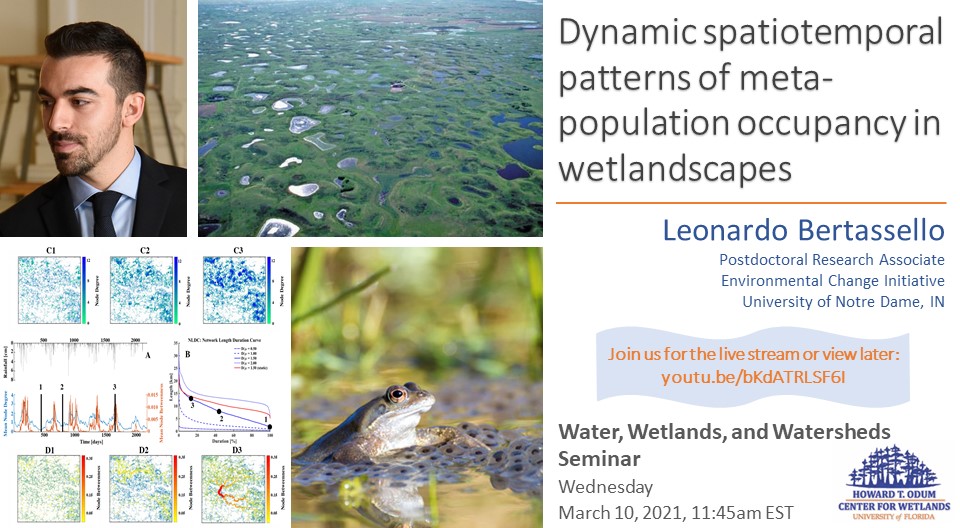March 10, 2021
Dynamic spatiotemporal patterns of metapopulation occupancy in wetlandscapes
Leonardo Bertassello, Postdoctoral Research Associate, Environmental Change Initiative, University of Notre Dame, IN
Join us for the live stream March 10, 11:45am EST: youtu.be/bKdATRLSF6I
ABSTRACT
Spatiotemporal dynamics in habitat suitability and connectivity among mosaics of heterogeneous wetlands are critical for biological diversity and species persistence in aquatic patchy landscapes. Despite the recognized importance of stochastic hydroclimatic forcing in driving wetlandscape hydrological dynamics, linking such effects to emergent dynamics of metapopulation poses significant challenges. To fill this gap, I developed a Dynamic Stochastic Patch Occupancy Model (SPOM), which links parsimonious hydrological and ecological models to simulate spatiotemporal patterns in species occupancy in wetlandscapes. The project aims to place ecological studies of patchy habitats into a proper hydrologic and climatic framework to improve the knowledge about metapopulation shifts in response to climate-driven changes in wetlandscapes. To assess the validity of the D-SPOM, I compared it with a long-term record of amphibian monitoring for R. pipiens over a 20-yr period at the Cottonwood Lake Study Area, CLSA in the Prairie Pothole Region. The stability of the mean hydroclimatic forcing during the two decades of amphibian monitoring and access to dense and diverse wetlands contributed to persistence of the R. pipiens metapopulation at the CLSA, despite seasonal and decadal spatiotemporal habitat dynamics. The amphibian occupancy pattern simulated for a larger domain surrounding the CLSA showed that the increased diversity of wetland habitats at regional scale dampens variability in patch occupancy, contributing to persistence in the R. pipiens metapopulation. The proposed D-SPOM framework is useful to understand how spatial heterogeneity in habitat attributes and temporal variability in hydroclimatic forcing could affect metapopulation persistence in dynamic wetlandscapes. This integrated perspective can then be used to guide monitoring and management strategies based on statistically representative areas of wetlandscapes.
Bio
Dr. Leonardo Bertassello received his Ph.D. in Civil and Environmental Engineering at Purdue University under the mentorship of Dr. Suresh Rao and Dr. Antoine Aubueneau. During his Ph.D. he developed stochastic hydrological models to analyze the spatiotemporal dynamics of multiple wetlands across landscapes. The characterization of wetland hydrologic dynamics is fundamental for all the ecological communities that live in these precious habitats. Guided by this motivation, during his previous Postdoctoral appointment at Purdue University (2019-2020) he expanded his research focus into the ecological dynamics of species that could inhabit wetlandscapes by employing metapopulation models and network-based approaches to represent wetlandscapes as patchy habitats that could be colonized or not by certain type of organisms. Dr. Bertassello joined ND-ECI in September 2020 as a Postdoctoral Research Associate and will be working under the mentorship of Dr. Marc Muller and Dr. Diogo Bolster on several projects focused on how the distribution and access to water resources can affect the distribution, interactions and resilience of human communities.
Seminar postcard

